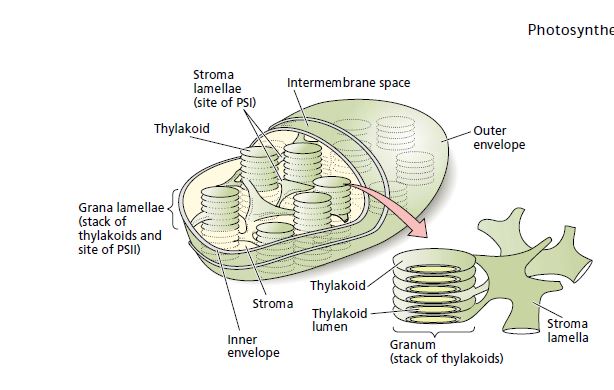Chloroplast , structure and functions in full details
What is
Chloroplast
Chloroplast
is a cell organelle and the site of photosynthesis in eukaryotic cells. Hence
they are present in plant cells and algae, but not in animal cells or bacteria
cells.
The
word 'Chloroplast' comes from a greek words;
"chloros"
which means "green"
"plastes"
wich means "the one who forms"
Chloroplasts
are present in all green coloured eukaryotic cells. Chloroplasts are the site
where the photosynthesis function is performed. In short Photosynthesis
occurs in eukaryotic cell structures called chloroplasts.
Structure
& Function of Chloroplast Components
Chloroplast
is made up of following components:
1) Envelope
Consists
of inner and outer phospholipid bilayers, each 6-8 nm thick, with a 10-20 nm
inter-membrane space in between.
Function:
Being semi-permeable, the envelope regulates the transportation of various
molecules like glucose, ions like Fe2+ and Mg2+, oxygen and carbon dioxide, in
and out of the envelope. It is also the site for synthesis of
certain lipids and light-harvesting pigments.
2) Stroma (Chloroplast
Matrix)
The aqueous matrix
encapsulated by the envelope and containing all internal components of the
chloroplast.
Function: Dark or
light-independent reactions occur at stroma. "The enzymes in the stroma
utilize carbon dioxide from the atmosphere, as well as the ATP and NADPH2
molecules released from grana, to synthesize sugar molecules and starch. This
process is also known as carbon dioxide fixation, and occurs through a series
of reactions collectively called Calvin cycle." [2]
Light-dependent oxygen fixation also occurs in stroma.
3) Thylakoids (each
thylakoid has a Lumen)
A
flattened membrane sac inside the chloroplast, used to convert light energy
into chemical energy. recganization of the protein complexes of the thylakoid membrane.
Photosystem II is located predominantly in the
stacked regions of the thylakoid membrane; photosystem I and
ATP
synthase are found in the unstacked regions protruding into the stroma.
Cytochrome b6 f complexes are evenly distributed. This lateral separation of
the two photosystems requires that electrons and protons produced by
photosystem II be transported a considerable distance before they can be acted
on by photosystem I and
Almost all the chemical processes that make up
the light reactions of photosynthesis are carried out by four major protein
complexes: photosystem II, the cytochrome b6 f complex, photosystem I, and the
ATP synthase. These four integral membrane complexes are vectorially oriented
in the thylakoid membrane to function .
•
Photosystem II oxidizes water to O2 in the thylakoid lumen and in the process
releases protons into the lumen.
•
Cytochrome b6 f receives electrons from PSII and delivers them to PSI. It also
transports additional protons into the lumen from the stroma.
•
Photosystem I reduces NADP+ to NADPH in the stroma by the action of ferredoxin
(Fd) and the flavoprotein ferredoxin–NADP reductase (FNR).
• ATP
synthase produces ATP as protons diffuse back through it from the lumen into
the stroma.
4) Grana (singular:
Granum)
Stack
of thylakoids in a chloroplast.
Function:
Light-dependent reactions occur at grana and thylakoids. It is the place where
photosynthetic pigments like chlorophyll a, chlorophyll b, carotenoids, etc.
absorb light energy, which in turn breaks down the water molecules, and finally
gives rise to ATP, NADPH2 and oxygen.
5) Lamellae
(singular: Lamella)
The
tissue that connects the grana to each other.
Function:
"Lamellae act as a 'skeleton' of the chloroplast, maintaining efficient
distances between the grana, thereby maximizing the overall efficiency of the
chloroplast." [1]
6) Circular
DNA
7) Starch
Granules
Starch
exists in chloroplast in the form of tiny little 'grains' or 'granules'.
Function:
They are the (insoluble) storage carbohydrate product of photosynthesis.
8) Lipid
Globules
9) Ribosomes
Chloroplasts
contain the smaller type of ribosomes (70S ribosomes), similar to the ones
found in the cytoplasm of prokaryotic cells.
Function:
Their main function is to serve as the site of mRNA translation.
10) Chlorophyll
Green
pigment in plants that absorbs light energy used to carry out photosynthesis.
11) Peripheral
Reticulum
In certain plants, an
additional set of membranous tubules budding off from the inner membrane of the
envelope.
Function: Fast transport
of metabolites and proteins from the inter-membrane space into the
chloroplasts.
Functions of
Chloroplast
1.
Absorption of light energy
and converting it into biological energy
2.
Production of NAPDH2 and evolution of oxygen through the process
of photosys of water.
3. Production of ATP by photophosphorylation. NADPH2 and ATP are
the assimilatory powers of photosynthesis. Transfer of CO2 obtained from the
air to 5 carbon sugar in the stream during dark reaction.
4.
Breaking of 6-carbon atom compound into two molecules of
phosphoglyceric acid by the utilization of assimilatory powers.
5.
Conversion of PGA into different sugars and store as stratch.
The chloroplast is very important as it is the cooking place for all the green
plants. All heterotrophs also depend on plasts for this food.





Comments
Post a Comment
Thanks for Comment....